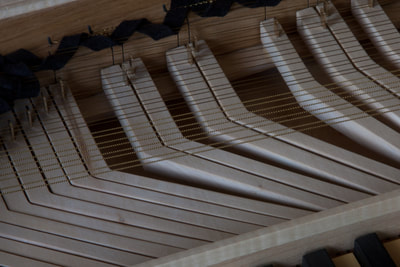Israel Gellinger clavichord 1670
Fretted clavichord (double and triple fretted) after Israel Gellinger 1670, Frankfurt am Main, Museum de Groesbeeck-de Croix, Namur, Belgium
C-c3, chromatic, complete bass octave without C#
48 keys
ca. 97 x 30 x 8 cm
The clavichord " Israel Gellinger 1670 " is a very small instrument showing some balance between a clear tone and limited dimensions. This clavichord is fretted from the second octave. The first octave is complete, except C#. The instrument is a faithful reconstruction of the clavichord signed in 1670 by Israel Gellinger, organist, and maker of musical instruments in Frankfurt. This interesting instrument, kept at the Museum de Groesbeeck-in Croix in Namur, Belgium, is an important witness of keyboard instruments make in Germany in the middle of the 17th century. For a full description of the original instrument, with photographs and details, see: Pierre Verbeek, The Israel Gellinger 1670 Clavichord, De Clavicordio VIII, Proc. of the VIII International Clavichord Symposium, Magnano, 5-8 September 2007, Ed. by Bernard Brauchli, Alberto Galazzo, Judith Wardman, ISBN 978-88-900269-5-9, p. 215-233.
C-c3, chromatic, complete bass octave without C#
48 keys
ca. 97 x 30 x 8 cm
The clavichord " Israel Gellinger 1670 " is a very small instrument showing some balance between a clear tone and limited dimensions. This clavichord is fretted from the second octave. The first octave is complete, except C#. The instrument is a faithful reconstruction of the clavichord signed in 1670 by Israel Gellinger, organist, and maker of musical instruments in Frankfurt. This interesting instrument, kept at the Museum de Groesbeeck-in Croix in Namur, Belgium, is an important witness of keyboard instruments make in Germany in the middle of the 17th century. For a full description of the original instrument, with photographs and details, see: Pierre Verbeek, The Israel Gellinger 1670 Clavichord, De Clavicordio VIII, Proc. of the VIII International Clavichord Symposium, Magnano, 5-8 September 2007, Ed. by Bernard Brauchli, Alberto Galazzo, Judith Wardman, ISBN 978-88-900269-5-9, p. 215-233.












